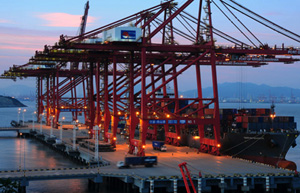China unveiled a detailed overcapacity replacement policy on Thursday that will promote cuts in the iron and steel, electrolytic aluminum, cement and glass industries.
In a key document last October, the State Council (cabinet) established the principle of replacing obsolete or excess capacity with an equal or smaller amount of new capacity. It said any region that wanted to establish new facilities in any of these sectors would have to shut outdated or excess factories before new lines would be permitted.
The idea was to create incentives for local governments to address concerns that despite years of talk about cutting excess production lines, new facilities were actually adding more capacity than was being eliminated. The result was unbearably high levels of capacity that squeezed manufacturers' profits.
For example, in 2011 and 2012, a total of 37 million metric tons of steel capacity was shut. But in those same years, 125 million tons of new steel capacity was built, according to the China Iron and Steel Association.
The latest plan hammered out by the Ministry of Industry and Information Technology will put the principle into practice.
First, the plan puts three economic hubs - the Beijing-Tianjin-Hebei region, the Yangtze River Delta and the Pearl River delta - into a category of their own. In these regions, new capacity will replace at least 1.25 times that much eliminated capacity.
In other regions, new capacity will replace old capacity on at least a one-for-one basis.
In early July, the MIIT announced the first batch of capacity to be closed, which covered 1,181 companies in 15 industries. Those facilities were told to close by Sept 30. More such lists are expected soon.
Feng Fei, head of the ministry's department of industrial policy, told China Daily that the "swapping" of new facilities for old ones includes not only those factories to be eliminated this year, but also in the following two years.
The idea is to avoid a repeat of the previous scenario "where old capacity was phased out, but new capacity far exceeded it", he said.
Second, the plan offers the option for local governments and enterprises to trade quotas. So if one province has good conditions for the development of the steel industry, which might mean building new facilities, but it doesn't have sufficient capacity to be eliminated, it could trade with another region that has excess capacity to be eliminated but few new projects in the pipeline.
The swap would give the first province a larger quota while providing the other province with money to fund its capacity elimination process.
The trading prices will be determined by the participants themselves, Feng said.
In a sign of the seriousness of this round of capacity cuts, the plan stipulates that only facilities designated by the MIIT as obsolete or excess capacity after 2013 may be used to trade. And capacity can only be used once.
Some analysts have expressed concern about whether there is sufficient "outdated" capacity to trade. Feng estimated that amount is less than 5 percent of the total after years of cuts. Another concern is whether investment in these four sectors will be suppressed and hurt the economy.
But Zhang Liqun, a researcher with the Development Research Center of the State Council, said China has to bear "transient pain" if it wants to upgrade its industrial sector.
|
 |
 |
| Economic reform remains at top of Party's agenda | China's economy heading in the right direction |
